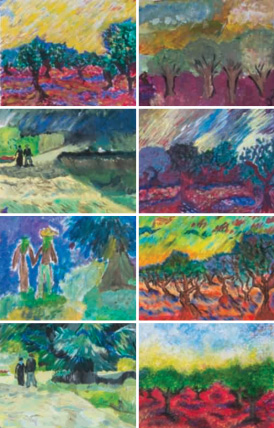Healing Arts
Students and Trainees Learn the Power of Integrating Art and Medicine

At paint nights, Art Club members work companionably on their individual pieces, often based on a common theme or prompt.
Many students at the College of Medicine are finding that involvement with the arts helps to enhance their medical school experience and may benefit their future patients.
Painting and drawing are among the activities pursued monthly by members of the College's Art Club, founded by third-year student Brian Park in early 2015. "I find that painting helps me process my experiences and slow down a little when the pace of medical school gets stressful," he says. "I thought others might benefit from this also." Ninety students participate in the club.
The club's goals are to serve as a creative outlet for expression and processing of feelings, provide a means of self-care, and help students develop and maintain a hobby to create balance in their lives, share their work with others, and recognize that medicine is an art as well as a science, according to Art Club adviser Florence Gelo, DMin, NCPsyA, associate professor, Department of Family, Community & Preventive Medicine.
Park notes that students enjoy painting with the club because it helps them relax and they enjoy the companionship of their peers. "Involvement with art also helps us become more conscious of how we feel," he says. "And knowing what we feel is important in patient care."
Art Club members have created a gallery of their work at the Queen Lane Campus, where they meet, and have also displayed their work at College events such as DUCOM Classical concerts. In addition to painting, the club has offered special programs such as a musical showcase night. They also collaborated with the Department of Psychology to host a breast cancer survivor who spoke about her experience and demonstrated how artistic expression helped her get through it.

In addition to paint nights, museum visits and guest speakers, the Art Club is talking about offering arts-and-crafts activities this year, according to second-year student Geena Chacko, incoming club president.
A second art club, known as the Art Collective, will officially launch in the fall. Led by second-year students Theodore Chung and Margaret Butchy, the group has been participating in unofficial activities since early 2016.
"A collective is a group of artists that work together, sharing resources and inspiration to hone their work," explains Butchy. "The mission of this collective is to study the intersection of the fine arts and medicine. The practices of art and medicine have a shared vocabulary: discovery, discipline, observation and empathy. The study of art helps physicians understand the human condition, as well as improving their creative thinking.
"We want to provide concrete experiences that will illustrate the diverse value of art in the practice of medicine, allowing students to exercise their humanity and integrate it into their role as physicians," Butchy continues. "We want to facilitate discussions between students that will encourage them to nurture their creative spirits and share their art with each other. We also hope to provide collaborations with physician writers, dance therapists and medical improvisation classes."
In addition to the art clubs, students and residents have the opportunity to explore the intersection between art and medicine through curricular courses and programs offered by Gelo.
Second- and third-year family medicine residents participate in ARTZ, a national program designed to help residents "develop a comforting confidence in interacting with people with dementia," according to Gelo, who coordinates Drexel's ARTZ program. During the community medicine rotation, residents visit a residential care facility for patients with dementia.

"Involvement with art also helps us become more conscious of how we feel. And knowing what we feel is important in patient care."
"I want the residents to see that interacting with art makes a difference for these patients," says Gelo. "When we arrive, the residents observe the patients who, in most cases, are just sitting in their chairs doing nothing. Then the residents begin helping the patients with simple artwork. Suddenly, patients who had nothing to say are trying to talk, making choices, interacting, laughing and sometimes remembering things."
Residents also visit an art museum with patients who have dementia, looking together at paintings and talking about them. "The residents see that even patients with severe expressive aphasia make an effort to communicate in this setting," Gelo notes.
"The ARTZ program provided great insight into how to counsel patients with dementia and their families on quality of life issues," says former resident Alexandra Schieber, MD. "I plan to encourage this type of activity for my patients."
Gelo also teaches Training the Physician's Eye, an elective humanities course that demonstrates the integration of art and medicine during student visits to local art museums. "This is an immersive experience in looking at art and then reflecting on the importance of observation before jumping to interpretation, a lesson with a strong parallel to medicine," Gelo emphasizes. "Students may see things differently, so they have to deal with different opinions, work as a team, verbalize their findings, and deal with uncertainty and ambiguity, just as they will as physicians."

Back to Top